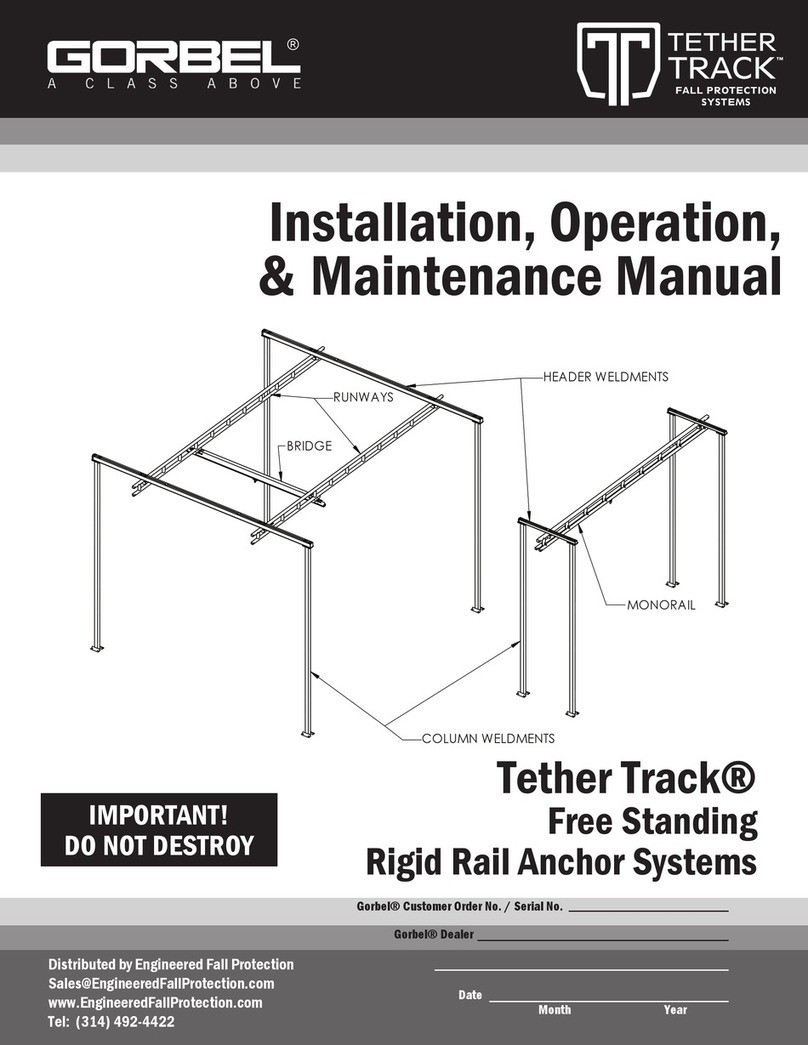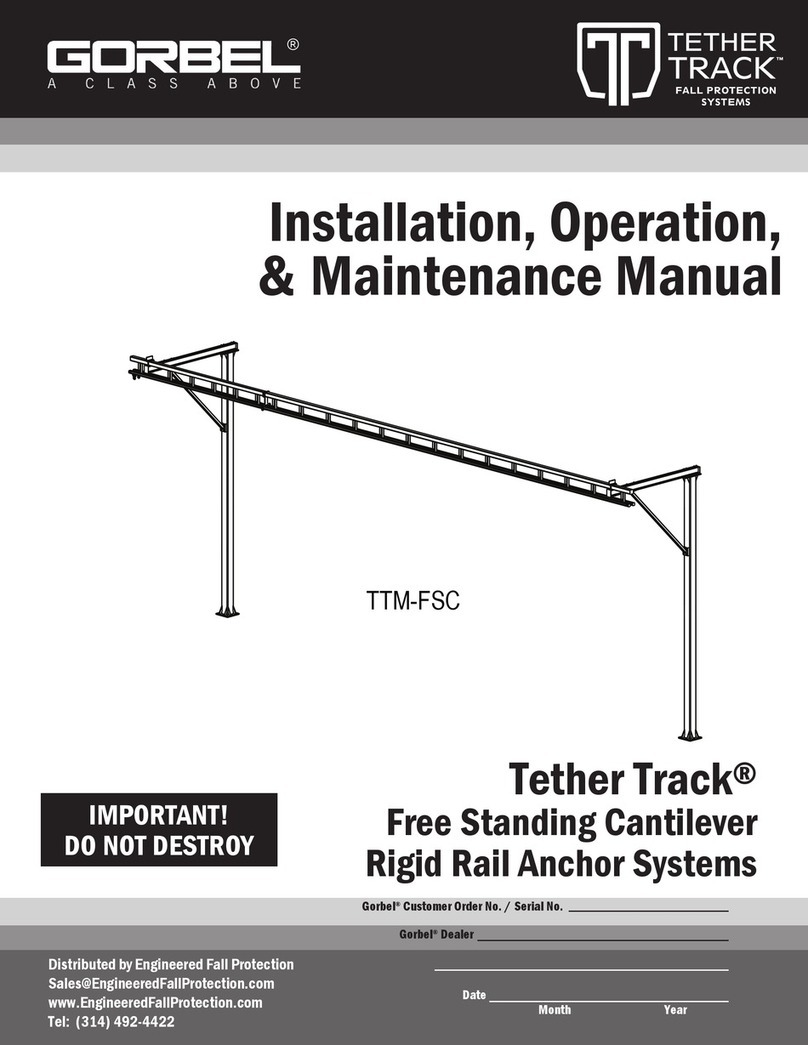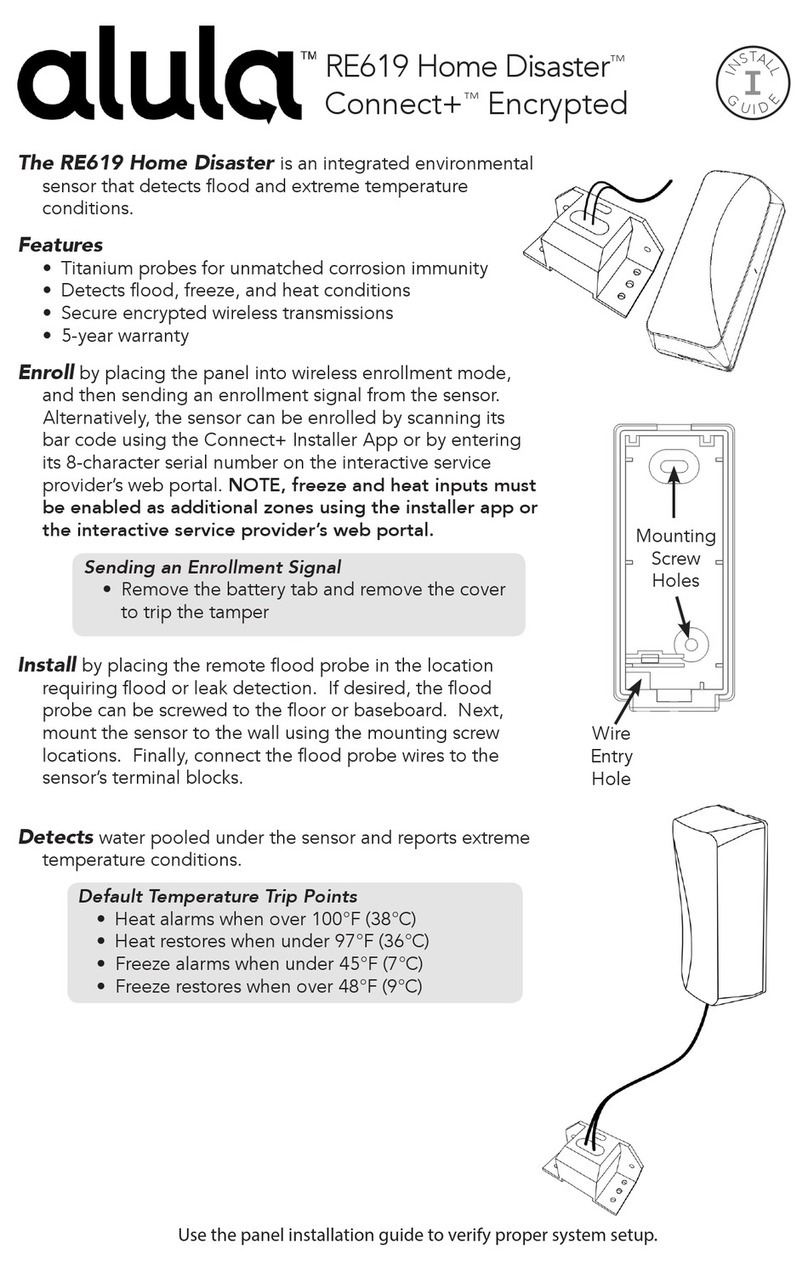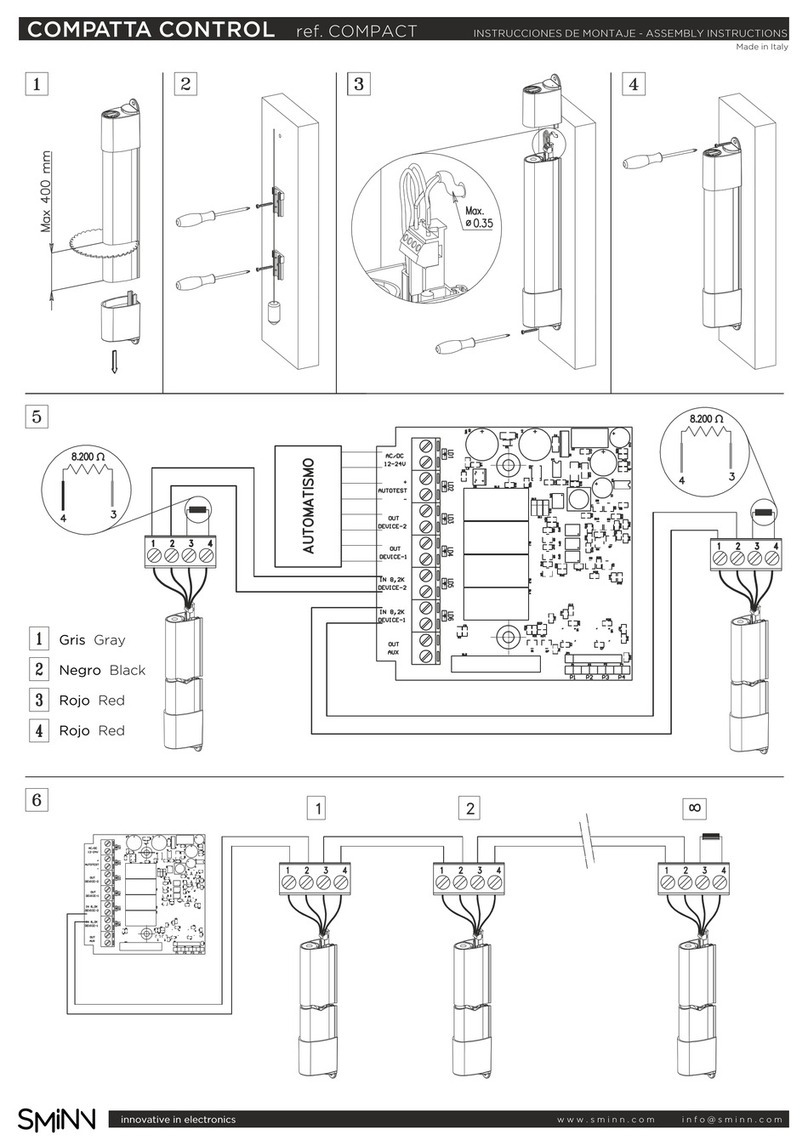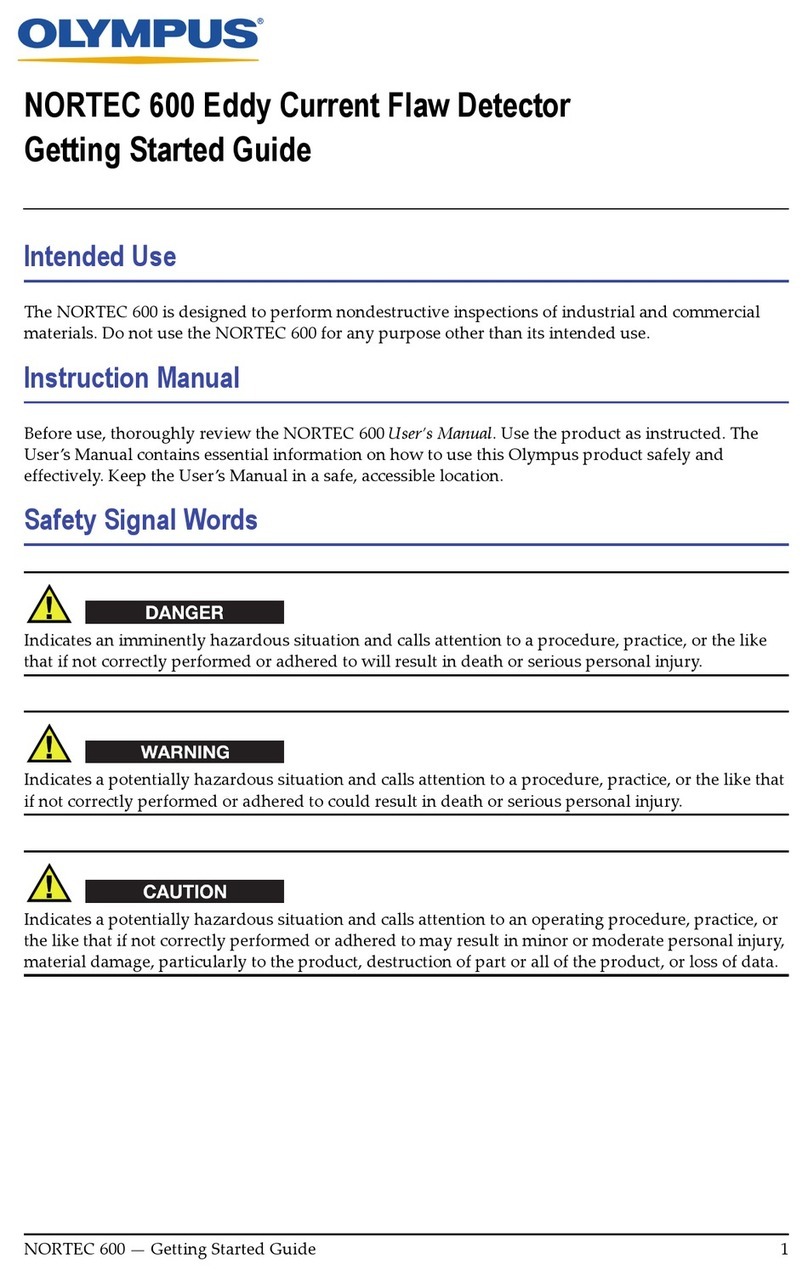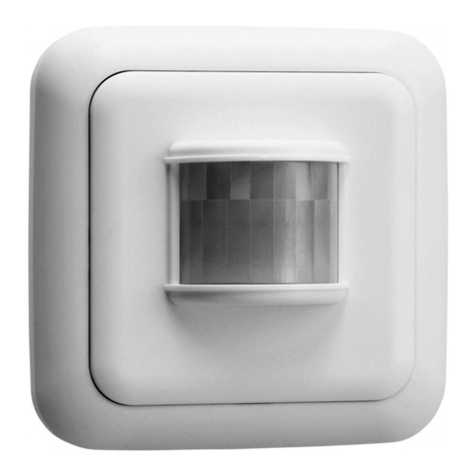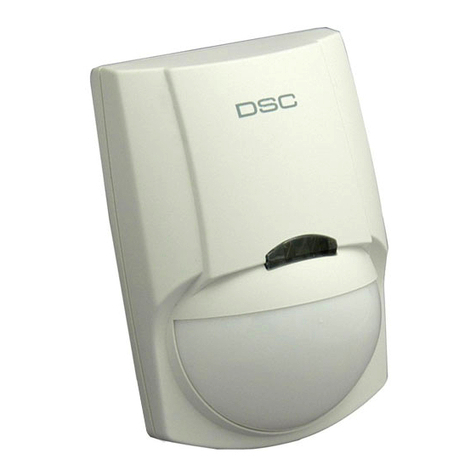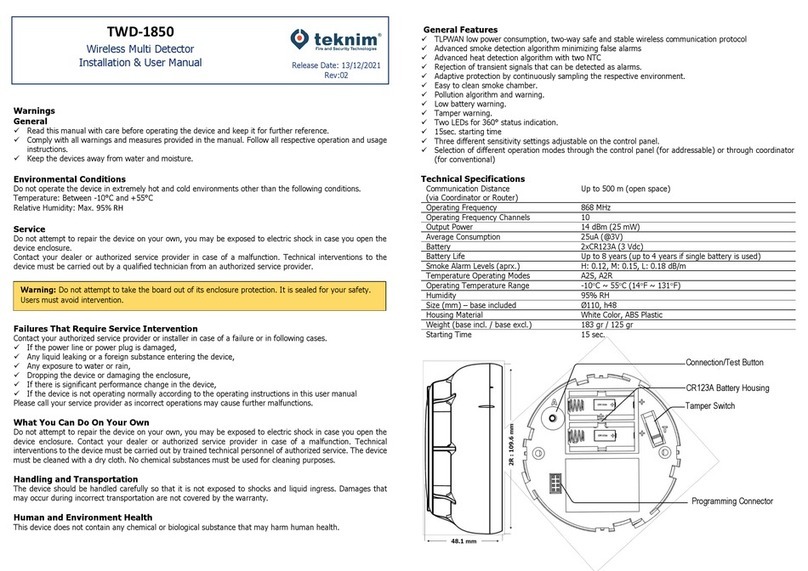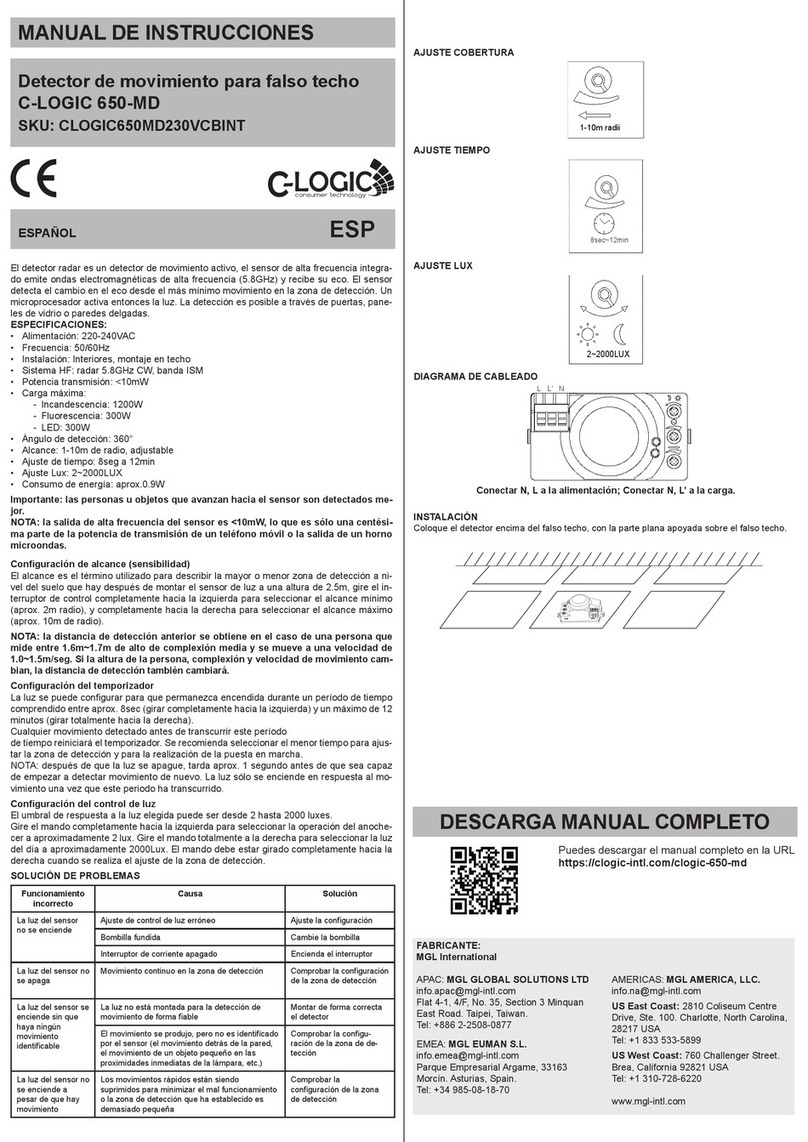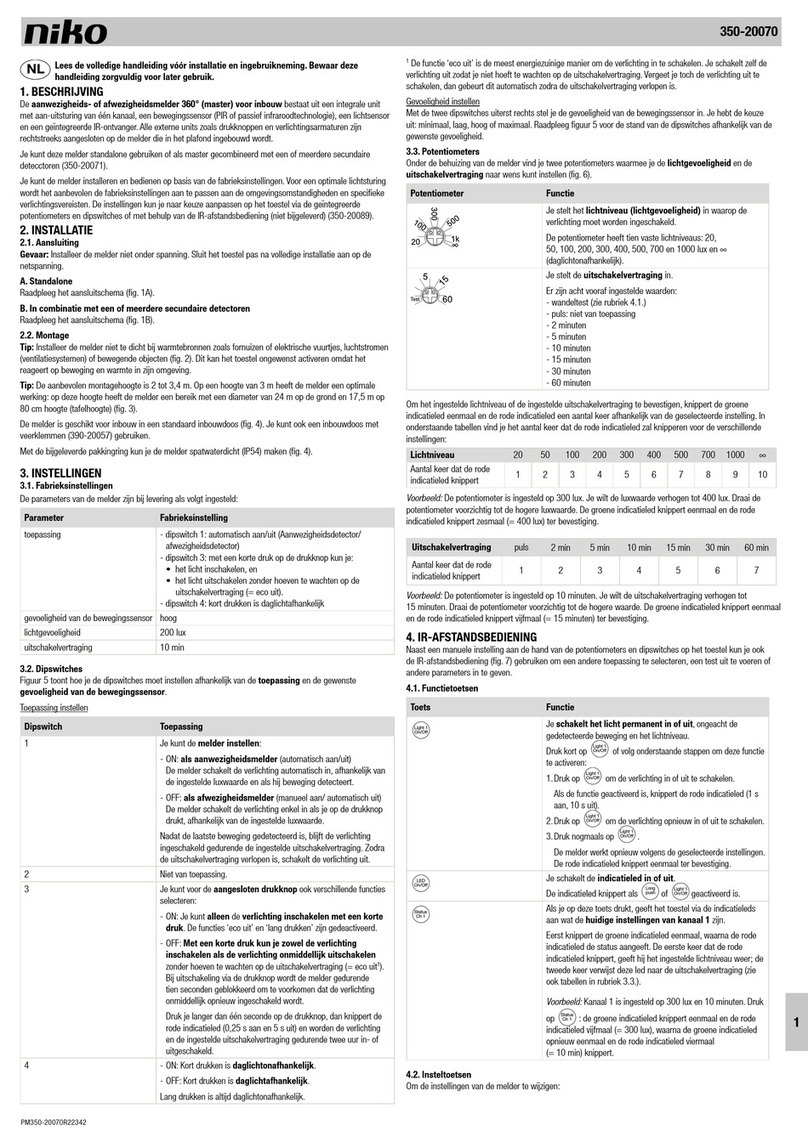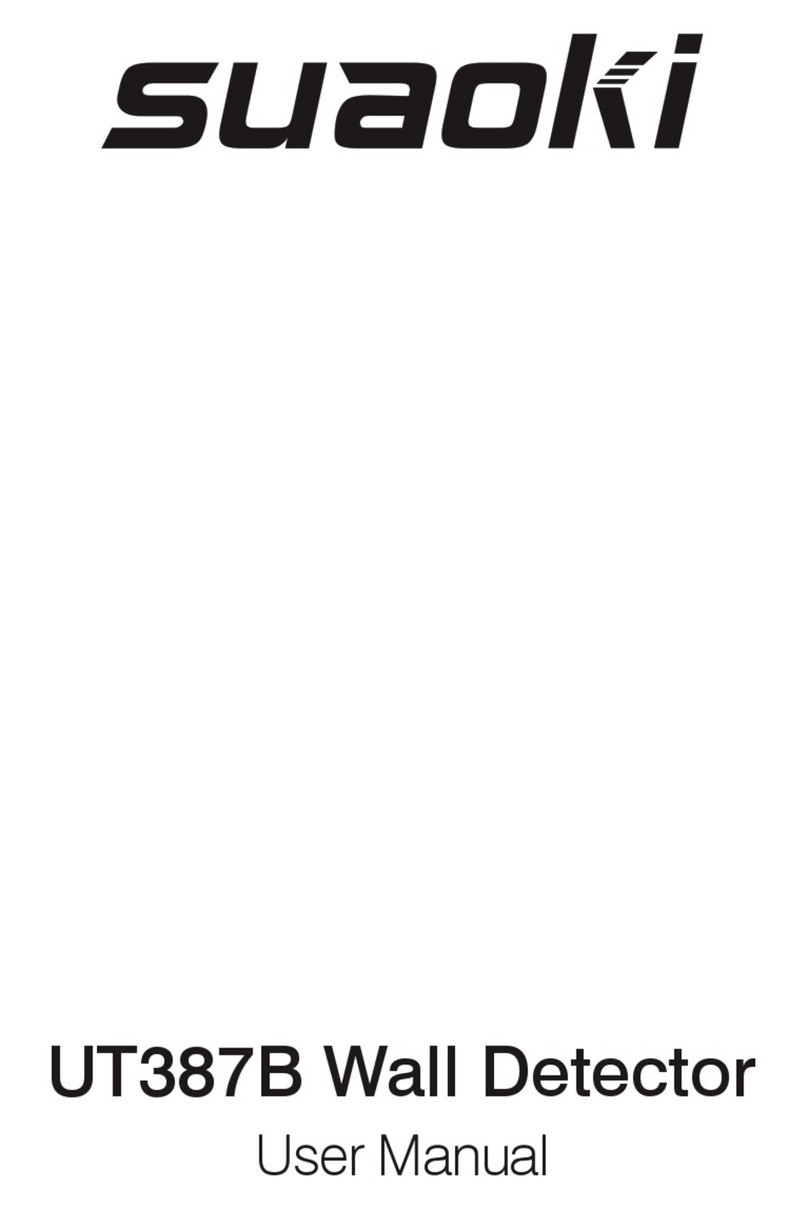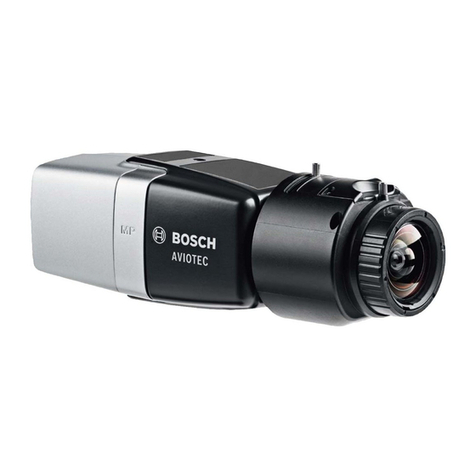GORBEL TETHER TRACK TTSA-FS Instruction manual

IMPORTANT!
DO NOT DESTROY
Installation, Operation,
& Maintenance Manual
Month Year
Gorbel®Dealer
Date
Tether Track®
Swing Arm Systems
Gorbel®Customer Order No. / Serial No.
®
TTSA-FS
TTSA
Distributed by Engineered Fall Protection
www.EngineeredFallProtection.com
Tel: (314) 492-4422

TABLE OF CONTENTS
Introduction................................................................................................... 1
Application.................................................................................................... 1
Warnings ...................................................................................................... 2
Restrictions................................................................................................... 3
Definition of Terms ....................................................................................... 3
Installation
Step 1 - Pre-assembly ............................................................................................4-6
Step 2 - Wall/Column Swing Arm Installation............................................................7
Step 3 - Free Standing Mast Installation ................................................................8-9
Step 4 - Free Standing Swing Arm Installation .......................................................10
Step 5 - Tether Track® Installation..........................................................................10
Step 6 - Trolley Installation......................................................................................11
Step 7 - Friction Brake Installation (Optional).....................................................11-13
Step 8 - Drive Installation (Optional) .......................................................................14
Step 9 - Electrification Installation (Optional) ..........................................................15
Step 9 - Rotation Stop Installation (Optional)..........................................................16
Step 10 - Final Steps ................................................................................................16
Fall Arrest System Requirements ..........................................................17-19
Labels......................................................................................................... 19
Authorized Person Instructions .................................................................. 20
General Operational Suggestions .............................................................. 21
Limited Warranty ........................................................................................ 22
Inspection and Maintenance Schedule ..................................................23-26

INTRODUCTION
Thank you for choosing a Tether Track® Swing Arm by Gorbel to solve your fall protection needs. Tether Track®
Swing Arms have been optimally designed to provide maximum protection for workers exposed to a fall hazard.
When properly applied, configured and installed under the supervision of a qualified person, Tether Track® Swing
Arms will allow the ultimate in user mobility by providing a mobile rigid anchorage for the attachment of a lanyard or
self-retracting lanyard (SRL). Using a SRL combined with the engineered cantilever anchorage, provides the
superior safety of a rigid system by minimizing fall distance while maximizing energy absorption of the fall arrest
force. This reliable performance combined with an ANSI approved Managed Fall Protection Program gives the user
the utmost safety assurance and encourages further safe work practices.
Tether Track® Swing Arms are designed using the most current ANSI guidelines and comply with all OSHA
requirements for a fall arrest anchorage system. The use of ANSI’s Maximum Average Arresting Force (MAAF) has
been incorporated into the design standards for the Tether Track® Swing Arm. Tether Track® Swing Arm systems
are designed to be statically proof tested up to 125% of the MAAF. If using lanyards or SRLs that are just rated for
Maximum Arresting Force (MAF), this MAF rating shall not exceed the MAAF rating of the Tether Track® Swing
Arm. When loaded through proof testing or during a fall event, the Tether Track® Swing Arm will not incur any
visual permanent deformation and may be placed back into service after performing the inspection requirements
detailed in this manual. Tether Track® Swing Arms have additionally been designed and tested to not sustain any
visible deformation under the maximum OSHA allowed 1800 lb. dynamic arresting force. All engineered Tether
Track® Swing Arm systems comply with OSHA’s required safety factor of 2 and are designed in accordance with
ANSI Z359.6.
The W-shape jib design provides the best economic flexibility to fit your specific fall zone requirements and
provides the best design to allow for the greatest fall clearance height. This combined with a mobile trolley within
our enclosed track all mounted on a freely pivoting hinge allows for the maximum ease of movement. These proven
designs have been utilized in Gorbel’s crane products for many years. Refer to the Introduction to Jib Cranes and
Introduction to Work Station Cranes for more details and additional definition of terms.
APPLICATION
Tether Track® Swing Arms are the best choice for providing coverage to a semi-circular fall zone. The rigid
anchorage, maintaining the anchorage trolley overhead and the use of a “Class A” Self Retracting Lanyard provides
the best solution to minimize fall distance when fall clearance height is restrictive. Note: specify Class A requirement
at time of quote, standard design is for “Class B” SRLs. The pivoting arm can be swung out of the way of overhead
cranes or equipment when the system is not in use. Thrust and pull forces are provided to determine the adequacy
of the available support structure. These forces are calculated using proof loading requirements of 1.25 * MAAF and
dead weight. When an existing support structure is unavailable or inadequate, Free Standing Tether Track® Swing
Arms can be provided. Foundation requirements are provided based on 3000 psi concrete strength and 2500 psi
allowable soil bearing strength.
When using a Tether Track® Swing Arm for more than one worker, either the motorized or friction brake option is
required. Both of these options, when properly adjusted, prevent excessive movement of the Swing Arm during a fall
event while limiting high lateral impact stresses in the swing arm and supporting structure.
This product meets all applicable OSHA and ANSI standard for all protection.
Dimensions contained in this installation manual are for reference only and may differ for your particular
application. Please refer to the enclosed General Arrangement Drawing for actual dimensions.
Normal safety precautions: These include, but are not limited to:
• Checking for obstructions in the fall clearance zone
• Coordinating fall hazard activities with assigned rescue personnel
• Making sure that end stops are in place
• Making sure that trolley freely moves
• For Motorized Swing Arms, verifying that lock out is in place
• When used by more than one worker at the same time, verifying friction brake or motorized clutch restricts
Swing Arm rotation
For additional safety precautions, see page 21.
1
10/12 Rev. E

WARNINGS
1. Do not throw away these instructions.
2. Only competent erection personnel familiar with standard fabrication practices should be employed to assemble
these anchor systems. Gorbel is not responsible for the quality of workmanship employed in the installation of an
anchor system according to these instructions. Contact Gorbel Inc. at 600 Fishers Run, P.O. Box 593, Fishers,
New York 14453-0593, 800-821-0086, for additional information if necessary.
3. Consult a qualified structural engineer to determine if your support structure is adequate to support the loads
generated by thrust and pull (wall/column mounted) or anchor bolt force, overturning moment, or axial load (free
standing) of your anchor system. Gorbel Inc. assumes no responsibility for the adequacy or integrity of mounting
surface.
4. Read and understand this manual before using equipment.
5. This manual should be read and understood in its entirety, and used as part of a training program as required by
OSHA or any state and local regulatory agency.
6. This and any other included instructions shall be provided to the users of this equipment. The user shall
understand the proper equipment use and limitations.
7. The Tether Track® Swing Arm Anchor System is only to be used as part of a complete fall protection system.
The buyer or user is responsible for the safety and compatibility of the complete system.
8. Any component replacement, addition or change to the anchor system or the complete system requires
evaluation by a qualified person.
9. Any fall event can result in injuries. The proper use of this equipment can substantially reduce an injury. For
maximum safety, the worker shall be trained in the proper use of this equipment and all of the components of
the fall arrest system.
10. Before each use, the equipment shall be inspected as outlined in the inspection section of this manual.
11. The rated capacity, the rated maximum average arresting force, and the rated maximum arresting force of the
Tether Track® Swing Arm Anchor System shall not be exceeded. If the lanyard or SRL connected to the Tether
Track® Swing Arm does not list a maximum average arresting force, the maximum average arresting force
rating listed shall not exceed the rated maximum average arresting force of the Tether Track® Swing Arm
Anchor System.
12. A managed fall protection program which includes a rescue plan is required for the safe use of this equipment.
A worker suspended from this system can lose vital blood flow to the brain as blood pools in the legs. This is
referred to as suspension trauma.
13. Reference the American Institute of Steel Construction (AISC) Manual of Steel Construction, Specification for
Structural Joints using ASTM A325 or A490 Bolts (section 8.d.2) for the proper procedures to follow when using
any torque tightening method.
14. Do not field modify the Tether Track® Swing Arm Anchor System in any way. Any modifications without the
written consent of Gorbel Inc. will void warranty.
15. Gorbel has ensured the compatibility of Tether Track® ONLY with a Gorbel® approved anchor connector (fall
arrest trolley). It is the responsibility of the dealer or end user to ensure proper design, function and compatibility
of any trolley used with Tether Track® that has not been validated by Gorbel for a fall arrest application.
16. When using a Tether Track® Swing Arm without any rotation restriction device, do not apply a lateral force of
greater than 10 lbs. A lateral force greater than 10 lbs may cause the Swing Arm to move until it reaches its
rotation limit and pay out all of the line in the SRL. This may cause the user to be pulled off their working surface.
17. When using a Tether Track® Swing Arm with more than one worker, a rotation restriction device shall be
engaged and an SRL with sufficient extra line (see page 16) shall be used. A leading edge fall arrest event may
cause the Swing Arm to center over the leading edge.
18. Failure to follow these instructions can result in serious injury or death.
210/12 Rev. E

RESTRICTIONS
1. The Tether Track® Swing Arm Anchor System shall be used as part of a complete active fall arrest system.
Neither Gorbel nor its distributor takes responsibility for the system as a whole. The Tether Track® Swing Arm
Anchor System is designed and tested by Gorbel in accordance with OSHA and ANSI Z359.1 & Z359.6
requirements using a minimum design factor of two. All components are designed in accordance with AISC
guidelines.
2. The end user shall be responsible to make sure that the complete Fall Arrest System shall be designed,
installed and used under the supervision of a qualified person in accordance with applicable OSHA regulations
and ANSI Z359 Fall Protection Code voluntary consensus standard. State and local jurisdictions may have
additional requirements.
3. It is the responsibility of the user to determine the sustainability of equipment and any attachments prior to each
use and to have certification inspection on a periodic basis with recurrence not to exceed once per year by a
qualified person.
4. Lanyards or self retracting lifelines (SRL) to be used with the Tether Track® Swing Arm Anchor System shall
have a maximum arresting force (MAF) equal to or less than 900 lbs or they shall have a maximum average
arresting force (MAAF) equal to or less than the MAAF rating of the Swing Arm.
5. Customer chosen lanyards or SRL shall minimize freefall distance.
6. It is the responsibility of the end user to verify that the mounting height of this Tether Track® Swing Arm Anchor
System will provide adequate fall clearance when used with the customer chosen lanyard or SRL and harness.
7. Each trolley shall have no more than one person attached.
8. Trolleys are designed to freely move. To prevent a swing fall and the lengthening of the free fall distance, the user
shall verify the trolley maintains the closest possible distance to the user whenever he or she changes position.
9. The Fall Clearance Zone shall be free of dangerous obstructions and electrical hazards as the Swing Arm may
slowly rotate to its travel limit during a fall arrest event.
10. A friction clutch (motorized) or an engaged friction brake is required when more than one person is using the
Swing Arm.
11. Only SRLs with sufficient reserve line shall be used when more than one person is using the Swing Arm. During
a leading edge fall event, the Swing Arm may move laterally up to four feet. Extra line is required to prevent the
second worker from being dislodged.
12. The Tether Track® Swing Arm Anchor System is intended only for indoor use.
13. The Tether Track® Swing Arm Anchor System shall be installed per the general arrangement drawing without
deviation or modification.
14. This system is not designed to be used as a crane.
DEFINITION OF TERMS
AUTHORIZED PERSON - ANSI defines an authorized person as a “person assigned by the employer to perform
duties at a location where the person will be exposed to a fall hazard”.
COMPLETE FALL ARREST SYSTEM - A complete fall arrest system consists of three main components:
A) Engineered Anchor System - Gorbel’s Tether Track® has been engineered to provide the maximum safety
possible. This system allows for the greatest worker mobility through Gorbel’s ergonomic enclosed track
design. It provides minimal fall distance by keeping the anchor point overhead and rigid.
B) Body Support - Only a full body harness is allowed for fall arrest systems. Proper fitting and wearing of the
harness is critical so that it can evenly dissipate the fall arrest forces to the strongest body parts.
C) Connecting Means - This is the link between the anchor and body support. A self-retracting lifeline is
recommended. This provides maximum mobility and minimum fall distance. An energy absorbing lanyard
may also be used. These components have a maximum arresting force rating. Gorbel’s standard Tether
Track® design is based on a maximum arresting force of 900 lbs. or less.
FALL CLEARANCE ZONE - The space below the person where there is a potential to fall. This space must remain
clear of obstructions to prevent injury from contact with any objects during a fall event.
QUALIFIED PERSON - ANSI defines a qualified person as “A person with a recognized degree or professional
certificate and with extensive knowledge, training and experience in the fall protection and rescue field who is
capable of designing, analyzing, evaluating and specifying fall protection and rescue systems...”
3
10/12 Rev. E

INSTALLATION
STEP 1 - PRE-ASSEMBLY
1.1 Read entire manual before installing the Swing Arm.
1.2 Check packing list to ensure no parts have been lost prior to initiating assembly.
1.3 Tools and materials (by others) typically needed to assemble Swing Arm:
• Torque wrench • Leveling tools and plumb bob
• Hand tools • Lifting device to lift heavy masts and swing arms
• Steel shims • Heavy duty drill
• Mounting hardware (by others, grade 5 bolts or better) for wall mounted swing arm
• Anchor bolts (by others, grade 5 bolts or better) for free standing swing arm
• Grout (Non-Shrink Precision Grout) for free standing swing arm
• Base plate template for free standing swing arm
1.4 Identify system type:
Wall Mounted Swing Arm (diagram 1A)
Refer to Chart 1A to determine thrust and pull,
bracket centers, and bolt pattern and dimensions,
then proceed to Step 2, page 7.
Free Standing Swing Arm (diagram 1B)
Refer to Charts 1B and 1C, on pages 5 and 6, to
determine anchor bolt load, footer width and depth
and mast size, then proceed to Step 3, page 8.
TIP: Packing list can be found in plastic pocket inside hardware box: General Arrangement Drawing can be
found inserted in this installation manual.
WARNING
Consult a qualified structural engineer to determine that your support structure is adequate to support the loads
generated by thrust and pull (wall mounted) or anchor bolt force, overturning moment, and axial load (free standing)
of your Tether Track® Swing Arm Anchorage System.
SPAN
CENTERS
BRACKET
6"
6"
OR 4" FOR B2
3 1/2" FOR B1
PULL
6"
7" 3"
3 1/2"
11/16"
HOLE
FOR 5/8" BOLT 5"
4"
13/16"
HOLE
FOR 3/4" BOLT
8"
8 1/4"
B1 BRACKET B2 BRACKET
PULL
THRUST
Diagram 1A. Wall Mounted Swing Arm.
MAST DIA.
SPAN
TS
WIDTH
DEPTH
Diagram 1B. Free Standing
Swing Arm.
410/12 Rev. E
Chart 1A. Wall Mounted Swing Arm *Standard Configurations.
SPAN
CENTERS
BRACKET
6"
6"
OR 4" FOR B2
3 1/2" FOR B1
PULL
6"
7" 3"
3 1/2"
11/16"
HOLE
FOR 5/8" BOLT 5"
4"
13/16"
HOLE
FOR 3/4" BOLT
8"
8 1/4"
B1 BRACKET B2 BRACKET
PULL
THRUST
NUMBER OF
WORKERS /
TRACK
SPAN (FT)
MODEL NUMBER
BRACKET
TYPE
**BRACKET
CENTERS (FT)
APPROX
WEIGHT (LBS)
***THRUST &
PULL (LBS)
1
8
10
12
14
16
18
20
22
24
26
28
30
TTSA-WC-B1-1P-8
TTSA-WC-B1-1P-10
TTSA-WC-B1-1P-12
TTSA-WC-B1-1P-14
TTSA-WC-B1-1P-16
TTSA-WC-B1-1P-18
TTSA-WC-B1-1P-20
TTSA-WC-B1-1P-22
TTSA-WC-B1-1P-24
TTSA-WC-B1-1P-26
TTSA-WC-B1-1P-28
TTSA-WC-B1-1P-30
B1
B1
B1
B1
B1
B1
B1
B1
B1
B1
B1
B2
3
3
3
3
4
4
5
5
6
6
6
6
215
249
365
410
472
604
681
840
926
1118
1672
1809
3106
3934
4929
5839
5085
5980
5409
6255
4795
6630
8310
9125
2
8
10
12
14
16
18
20
22
24
26
28
30
TTSA-WC-B1-2P-8
TTSA-WC-B1-2P-10
TTSA-WC-B1-2P-12
TTSA-WC-B1-2P-14
TTSA-WC-B1-2P-16
TTSA-WC-B1-2P-18
TTSA-WC-B2-2P-20
TTSA-WC-B2-2P-22
TTSA-WC-B2-2P-24
TTSA-WC-B2-2P-26
TTSA-WC-B2-2P-28
TTSA-WC-B2-2P-30
B1
B1
B1
B1
B1
B1
B2
B2
B2
B2
B2
B2
3
4
4
5
6
6
6
6
6
6
6
6
312
383
441
586
755
824
1035
1512
1619
1726
1833
2129
6120
5804
7031
6715
6560
7460
8525
10140
11240
12370
13530
15118
* All Standard Configurations are based on a 900 lb. MAAF (for ANSI Z359.13 or
Z359.14 rated lanyard or SRL) or 900 lb. MAF (for other rated lanyard or SRL)
** Custom bracket centers are available (will affect loadings).
*** Thrust and pull force is based on proof load (1.25 * 900 lb (MAAF or MAF) +
dead load)

NUMBER OF
WORKERS /
TRACK
TROLLEY
SADDLE
(FT)
SPAN
(FT) MODEL NUMBER
MAST
DIAMETER
(IN)
**FOOTING
DEPTH (IN)
**FOOTING
WIDTH (FT)
APPROX.
WEIGHT
(LBS)
***ANCHOR
BOLT LOAD
(LBS)
1
14
8
10
12
14
16
18
20
22
24
26
28
30
TTSA-FS-WC-B1-1P-8-14
TTSA-FS-WC-B1-1P-10-14
TTSA-FS-WC-B1-1P-12-14
TTSA-FS-WC-B1-1P-14-14
TTSA-FS-WC-B1-1P-16-14
TTSA-FS-WC-B1-1P-18-14
TTSA-FS-WC-B1-1P-20-14
TTSA-FS-WC-B1-1P-22-14
TTSA-FS-WC-B1-1P-24-14
TTSA-FS-WC-B1-1P-26-14
TTSA-FS-WC-B1-1P-28-14
TTSA-FS-WC-B1-1P-30-14
8.625
12.75
12.75
12.75
12.75
12.75
12.75
12.75
14
14
14
16
6
48
48
48
48
48
48
48
48
48
48
48
6.3
4
4.25
4.5
4.75
5
5
5.25
5.5
5.75
6.25
6.5
687
905
1028
1072
1135
1272
1349
1514
2018
2217
2782
3129
2146
2837
3626
4358
5113
6066
6906
8035
7123
8207
10370
4475
16
8
10
12
14
16
18
20
22
24
26
28
30
TTSA-FS-WC-B1-1P-8-16
TTSA-FS-WC-B1-1P-10-16
TTSA-FS-WC-B1-1P-12-16
TTSA-FS-WC-B1-1P-14-16
TTSA-FS-WC-B1-1P-16-16
TTSA-FS-WC-B1-1P-18-16
TTSA-FS-WC-B1-1P-20-16
TTSA-FS-WC-B1-1P-22-16
TTSA-FS-WC-B1-1P-24-16
TTSA-FS-WC-B1-1P-26-16
TTSA-FS-WC-B1-1P-28-16
TTSA-FS-WC-B1-1P-30-16
8.625
12.75
12.75
12.75
12.75
12.75
14
14
14
14
16
16
6
48
48
48
48
48
48
48
48
48
48
48
6.3
4
4.25
4.5
4.5
5
5
5.25
5.5
5.75
6.25
6.5
731
972
1095
1139
1201
1339
1873
2041
2128
2326
3117
3254
2134
2819
3608
4340
5095
6048
5421
6333
7095
8178
4289
4739
18
8
10
12
14
16
18
20
22
24
26
28
30
TTSA-FS-WC-B1-1P-8-18
TTSA-FS-WC-B1-1P-10-18
TTSA-FS-WC-B1-1P-12-18
TTSA-FS-WC-B1-1P-14-18
TTSA-FS-WC-B1-1P-16-18
TTSA-FS-WC-B1-1P-18-18
TTSA-FS-WC-B1-1P-20-18
TTSA-FS-WC-B1-1P-22-18
TTSA-FS-WC-B1-1P-24-18
TTSA-FS-WC-B1-1P-26-18
TTSA-FS-WC-B1-1P-28-18
TTSA-FS-WC-B1-1P-30-18
8.625
12.75
12.75
12.75
12.75
14
14
14
14
16
16
18
6
48
48
48
48
48
48
48
48
48
48
48
6.3
4
4.25
4.5
4.5
4.75
5
5.25
5.5
5.75
6.25
6.25
776
1038
1161
1206
1268
1905
1982
2150
2237
2676
3243
3649
2122
2801
3590
4322
5078
4713
5393
6304
7066
3368
4272
4001
20
8
10
12
14
16
18
20
22
24
26
28
30
TTSA-FS-WC-B1-1P-8-20
TTSA-FS-WC-B1-1P-10-20
TTSA-FS-WC-B1-1P-12-20
TTSA-FS-WC-B1-1P-14-20
TTSA-FS-WC-B1-1P-16-20
TTSA-FS-WC-B1-1P-18-20
TTSA-FS-WC-B1-1P-20-20
TTSA-FS-WC-B1-1P-22-20
TTSA-FS-WC-B1-1P-24-20
TTSA-FS-WC-B1-1P-26-20
TTSA-FS-WC-B1-1P-28-20
TTSA-FS-WC-B1-1P-30-20
12.75
12.75
12.75
12.75
14
14
14
14
16
16
18
18
6
48
48
48
48
48
48
48
48
48
48
48
6.2
4
4.25
4.5
4.5
4.75
5
5.25
5.5
5.75
6.25
6.25
1072
1105
1228
1273
1873
2014
2091
2259
2601
2801
3653
3790
2119
2783
3573
4304
3915
4684
5364
6276
2898
3352
3595
3983
22
8
10
12
14
16
18
20
22
24
26
28
30
TTSA-FS-WC-B1-1P-8-22
TTSA-FS-WC-B1-1P-10-22
TTSA-FS-WC-B1-1P-12-22
TTSA-FS-WC-B1-1P-14-22
TTSA-FS-WC-B1-1P-16-22
TTSA-FS-WC-B1-1P-18-22
TTSA-FS-WC-B1-1P-20-22
TTSA-FS-WC-B1-1P-22-22
TTSA-FS-WC-B1-1P-24-22
TTSA-FS-WC-B1-1P-26-22
TTSA-FS-WC-B1-1P-28-22
TTSA-FS-WC-B1-1P-30-22
12.75
12.75
12.75
12.75
14
14
14
14
16
16
18
20
6
48
48
48
48
48
48
48
48
48
48
48
6.2
4
4.25
4.5
4.5
4.75
5
5.25
5.5
5.75
6.25
6.25
1138
1172
1295
1339
1982
2123
2200
2369
2727
2926
3794
4904
2101
2765
3555
4286
3886
4655
5335
6247
2882
3335
3577
3336
Chart 1B. Single Person, Single Track Free Standing Swing Arm *Standard Configurations.
5
10/12 Rev. E
* All Standard Configurations are based on a 900 lb. MAAF (for ANSI Z359.13 or Z359.14 rated lanyard or SRL) or 900 lb. MAF (for other rated lanyards or SRLs)
** Footing size is based on a 1.5 overturning safety factory of proof loading
*** Anchor bolt load is based on proof load (1.25 * 900 lb (MAAF or MAF) + dead load)

NUMBER OF
WORKERS /
TRACK
TROLLEY
SADDLE
(FT)
SPAN
(FT) MODEL NUMBER
MAST
DIAMETER
(IN)
**FOOTING
DEPTH (IN)
**FOOTING
WIDTH (FT)
APPROX.
WEIGHT
(LBS)
***ANCHOR
BOLT LOAD
(LBS)
2
14
8
10
12
14
16
18
20
22
24
26
28
30
TTSA-FS-WC-B1-2P-8-14
TTSA-FS-WC-B1-2P-10-14
TTSA-FS-WC-B1-2P-12-14
TTSA-FS-WC-B1-2P-14-14
TTSA-FS-WC-B1-2P-16-14
TTSA-FS-WC-B1-2P-18-14
TTSA-FS-WC-B2-2P-20-14
TTSA-FS-WC-B2-2P-22-14
TTSA-FS-WC-B2-2P-24-14
TTSA-FS-WC-B2-2P-26-14
TTSA-FS-WC-B2-2P-28-14
TTSA-FS-WC-B2-2P-30-14
12.75
12.75
12.75
12.75
14
14
14
14
14
16
16
18
48
48
48
48
48
48
48
48
48
48
48
48
4.5
4.75
5
5.5
5.75
6
6.25
6.5
6.75
7
7.25
7.5
974
1045
1103
1254
1847
1916
2134
2622
2729
3046
3153
3697
4481
5788
7113
8579
8035
9224
10619
12714
14173
6522
7169
6589
16
8
10
12
14
16
18
20
22
24
26
28
30
TTSA-FS-WC-B1-2P-8-16
TTSA-FS-WC-B1-2P-10-16
TTSA-FS-WC-B1-2P-12-16
TTSA-FS-WC-B1-2P-14-16
TTSA-FS-WC-B1-2P-16-16
TTSA-FS-WC-B1-2P-18-16
TTSA-FS-WC-B2-2P-20-16
TTSA-FS-WC-B2-2P-22-16
TTSA-FS-WC-B2-2P-24-16
TTSA-FS-WC-B2-2P-26-16
TTSA-FS-WC-B2-2P-28-16
TTSA-FS-WC-B2-2P-30-16
12.75
12.75
12.75
12.75
14
14
14
14
16
16
18
18
48
48
48
48
48
48
48
48
48
48
48
48
4.5
4.75
5
5.5
5.75
6
6.25
6.5
6.75
7
7.25
7.5
1041
1112
1170
1321
1956
2025
2243
2731
3064
3171
3531
3838
4464
5770
7096
8561
8007
9195
10590
12686
5877
6506
6089
6841
18
8
10
12
14
16
18
20
22
24
26
28
30
TTSA-FS-WC-B1-2P-8-18
TTSA-FS-WC-B1-2P-10-18
TTSA-FS-WC-B1-2P-12-18
TTSA-FS-WC-B1-2P-14-18
TTSA-FS-WC-B1-2P-16-18
TTSA-FS-WC-B1-2P-18-18
TTSA-FS-WC-B2-2P-20-18
TTSA-FS-WC-B2-2P-22-18
TTSA-FS-WC-B2-2P-24-18
TTSA-FS-WC-B2-2P-26-18
TTSA-FS-WC-B2-2P-28-18
TTSA-FS-WC-B2-2P-30-18
12.75
12.75
14
14
14
14
14
16
16
18
18
20
48
48
48
48
48
48
48
48
48
48
48
48
4.5
4.75
5
5.5
5.75
6
6.25
6.5
6.75
7
7.25
7.5
1108
1179
1733
1887
2065
2134
2352
3083
3189
3566
3673
4824
4446
5752
5537
6721
7978
9167
10562
5249
5861
5514
6071
5860
20
8
10
12
14
16
18
20
22
24
26
28
30
TTSA-FS-WC-B1-2P-8-20
TTSA-FS-WC-B1-2P-10-20
TTSA-FS-WC-B1-2P-12-20
TTSA-FS-WC-B1-2P-14-20
TTSA-FS-WC-B1-2P-16-20
TTSA-FS-WC-B1-2P-18-20
TTSA-FS-WC-B2-2P-20-20
TTSA-FS-WC-B2-2P-22-20
TTSA-FS-WC-B2-2P-24-20
TTSA-FS-WC-B2-2P-26-20
TTSA-FS-WC-B2-2P-28-20
TTSA-FS-WC-B2-2P-30-20
12.75
12.75
14
14
14
14
16
16
18
18
20
20
48
48
48
48
48
48
48
48
48
48
48
48
4.5
4.75
5
5.5
5.75
6
6.25
6.5
6.75
7
7.25
7.5
1175
1246
1842
1996
2174
2243
2718
3208
3600
3707
4720
5032
4428
5734
5509
6693
7950
9138
4358
5233
4954
5496
5175
5833
22
8
10
12
14
16
18
20
22
24
26
28
30
TTSA-FS-WC-B1-2P-8-22
TTSA-FS-WC-B1-2P-10-22
TTSA-FS-WC-B1-2P-12-22
TTSA-FS-WC-B1-2P-14-22
TTSA-FS-WC-B1-2P-16-22
TTSA-FS-WC-B1-2P-18-22
TTSA-FS-WC-B2-2P-20-22
TTSA-FS-WC-B2-2P-22-22
TTSA-FS-WC-B2-2P-24-22
TTSA-FS-WC-B2-2P-26-22
TTSA-FS-WC-B2-2P-28-22
TTSA-FS-WC-B2-2P-30-22
12.75
12.75
14
14
14
16
16
16
18
18
20
20
48
48
48
48
48
48
48
48
48
48
48
48
4.25
4.75
5
5.5
5.75
6
6.25
6.5
6.75
7
7.25
7.5
1241
1312
1951
2106
2284
2624
2843
3333
3741
3848
4928
5240
4410
5717
5480
6664
7921
3757
4341
5217
4936
5478
5148
5807
610/12 Rev. E
Chart 1C. Two Person, Dual Track Free Standing Swing Arm *Standard Configurations.
* All Standard Configurations are based on a 900 lb. MAAF (for ANSI Z359.13 or Z359.14 rated lanyard or SRL) or 900 lb. MAF (for other rated lanyards or SRLs)
** Footing size is based on a 1.5 overturning safety factory of proof loading
*** Anchor bolt load is based on proof load (1.25 * 900 lb (MAAF or MAF) + dead load)

7
10/12 Rev. E
STEP 2 - WALL/COLUMN MOUNTED SWING ARM INSTALLATION
2.1 Determine position of upper-formed channel bracket on support structure. Drill
bolt holes (see chart 1A and diagram 1A, page 4, for bolt diameter and bolt to
support structure.
2.2 Determine position of lower formed channel bracket by measuring distance
between bracket centers; clamp bracket to support structure. Align brackets by
dropping plumb bob (by others) through pivot holes and making sure string is
centered in pivot holes (diagram 2A). Shim, if necessary, between mounting
surface and formed channel brackets (shims by others).
2.3 Drill bolt holes for lower bracket (see chart 1A and diagram 1A, page 4,
for bolt diameter) and bolt to support structure. Do not torque bolts until
Swing Arm has been checked for drift (Step 2.5).
2.4 Attach Swing Arm assembly to formed channel using hardware provided (diagram 2B). Be sure that thrust
washers are in position. Tighten nuts on pivot bolt until lockwashers are compressed, being sure boom
freely rotates.
2.5 Carefully swing arm through entire travel to ensure boom is clear of obstructions and does not drift.
If Swing Arm drifts, support structure may be inadequate and/or shims may be required between mounting
surface and channel brackets (refer to Step 2.2 for pivot mounting assembly alignment).
2.6 Torque mounting bolts (grade 5 or better, by others) to manufacturer’s specifications.
2.7 Proceed to Step 5 on page 10.
TIP: Upper and lower formed channel (brackets) are identical unless a rotation stop is welded to the bracket. In
this case, the rotation stop bracket is the upper bracket (refer to Step 10, page 16).
STOP!
Do not proceed if your support structure does not meet the loading requirements determined in Step 1.4.
Diagram 2A. Plumbing
formed channel brackets.
Diagram 2B. Attaching Swing Arm assembly to formed channel.

STEP 3 - FREE STANDING MAST INSTALLATION
3.1 INSTALLING ANCHOR BOLTS
3.1.1 Refer to diagram 3A or 3B and chart 3A for bolt hole size and pattern for base plate thickness.
3.1.2 Cast-in Anchor Bolts with Poured Foundations
(6 or 12 bolt pattern):
A) Anchor bolts (by others) must:
• be 1” diameter for 1-1/4” diameter base plate holes and
1-1/4” diameter for 1-1/2” diameter base plate holes.
• be embedded 3/4 of footer depth (L).
• have minimum of two threads above nut after installation.
B) Create steel-reinforced concrete foundation using
recommendations shown in diagram 3C.
Refer to chart 1B, page 5, or chart 1C, page 6, for footer depth (L)
and footer width (M) in diagram 3C.
Note: 7/16” thick, wafer board, bolt hole templates are available to
facilitate anchor bolt alignment. Foundation requirements are based
on soil pressure of 2500# per square foot. Concrete
pressure recommended for foundation is 3000# per square
inch of compressive force.
Note: Foundation/concrete must cure seven (7) days prior to mast
installation. Foundation/concrete must cure 28 days prior to
using Swing Arm.
C) Proceed to Step 3.2, page 9, for mast installation and
plumbing.
STOP!
Do not proceed if your foundation does not meet the size and loading requirements identified in Step 1.4.
WARNING
Consult a qualified structural engineer if you deviate from the recommended dimensions provided
in this manual or the General Arrangement Drawing. Gorbel, Inc. is not responsible for any deviation
from these foundation recommendations.
60°
MAST
HOLE
2"
OFFSET
B.C.
Diagram 3A. 6 bolt base bolt pattern.
60°
HOLE
MAST
4"
2"
OFFSET
B.C.
Diagram 3B. 12 bolt base bolt pattern.
Diagram 3C. Poured foundation.
Chart 3A. Base plate dimensions.
810/12 Rev. E
Mast Diameter
8-5/8” 12-3/4” 14” 16” 18” 20”
6 Bolt or 12 Bolt Base 6 6 6 12 12 12
Diameter of Bolt
Circle (B.C.) 24” 24” 30” 36” 42” 48”
Diameter of Bolt Hole 1-1/4” 1-1/2” 1-1/2” 1-1/2” 1-1/2” 1-1/2”
Hole Stiffener No Yes Yes Yes Yes Yes
Base Plate Thickness
Including Stiffener 1/2” 1-1/4” 1-1/4” 1-1/4” 1-1/4” 1-1/4”
TIP: Cast-in anchor bolts (J bolts) typically protrude
6” above foundation before mast is installed.

STEP 3 - FREE STANDING MAST INSTALLATION (CONTINUED)
3.1 INSTALLING ANCHOR BOLTS (CONTINUED)
3.1.3 Post-Installed Anchor Bolts with Shallow Foundations (6 bolt pattern):
In addition to the requirements identified in Step 1.4, a minimum 6” thick reinforced concrete floor that is
free of cracks, seams, expansion joints, and walls is required. Foundation requirements are based on a
concrete compressive strength of 3000# per square inch, a soil bearing pressure of 2500# per square foot,
and a modulus of subgrade reaction of 150# per square inch per inch.
A) Anchor bolts (by others) must:
• have an ICC-ES listing demonstrating suitability for the application.
• be installed in accordance with the manufacturer’s instructions and requirements.
B) Base plate may be used as a template to drill holes in concrete floor. Follow anchor bolt manufacturer’s
recommendations for drill bit size, depth, and special inspection requirements.
Note: Base plates are designed for poured foundations. Hole size may exceed anchor bolt manufacturer’s
recommendations. Contact Gorbel® Customer Service if a custom base plate is required. Drill
bushings or equivalent may also be used to reduce hole clearance. Bushings must not protrude above
base plate. If base plate hole diameter is greater than
bolt diameter plus 1/4”, refer to AISC Design Guide 1 for
minimum washer size and thickness recommendations.
C) Install anchor bolts and hardware according to
manufacturer’s installation instructions. Diagram 3D shows
a typical installation.
Note: Before tightening hardware, follow instructions in Step
3.2 for applying and curing grout.
3.2 Installing and Plumbing Mast
A) Cover entire base plate area with one inch of non-shrink precision grout.
B) Set mast into place and make sure that the base plate is completely
seated in the grout.
C) Thread a plumb line through Swing Arm mounting bracket holes and
hole in tapered plug (by others) as shown in diagram 3E.
D) Adjust mast as required until plumb line is centered in all the mounting
hole brackets.
E) Once mast is plumb and grout has cured, fully
tighten anchor bolt hardware.
F) Verify mast is still plumb.
DO NOT USE A LEVEL
TO PLUMB MAST.
WARNING
Shallow foundations are only appropriate for 8 foot span, one worker Swing Arms.
A A
6" 4"
1"
GROUT
EFFECTIVE
EMBEDMENT
QUALIFIED ADHESIVE
BASE PLATE W/
STIFFENER
1-1/2" OD X 1-1/8" ID
X 1" BUSHING
2-1/2" OD X 1-1/16" ID
X 1/4" WASHER
1"-8 X 8" A193/B7 STUD HEXNUT
Diagram 3D. Anchor bolt installation.
9
10/12 Rev. E
WARNING
Mast must be plumb to prevent Swing Arm from drifting.
TAPERED PLUG W/
CENTER HOLE
PLUMB BOB
Diagram 3E. Plumbing the
mast.

STEP 4 - FREE STANDING SWING ARM INSTALLATION
4.1 Attach Swing Arm to formed channel using hardware provided (diagram 4A). Be sure that thrust washers are
in position. Tighten nuts on pivot bolt until lockwashers are compressed, being sure boom rotates freely.
4.2 Carefully swing arm through entire travel to ensure arm is clear of obstructions and does not drift.
If Swing Arm drifts, check to make sure mast is plumb
and/or Swing Arm is squarely supported by both formed
channel brackets. Shims may be used between thrust
washer and channel bracket.
STEP 5 - TETHER TRACK® INSTALLATION
5.1 Slide Tether Track® through all track supports on Swing
Arm. Track must not extend further than 18” from the end
of the arm.
5.2 Thread jam nuts down on clamping bolts (two at each
track support). Thread clamping bolts with jam nuts into
track supports and tighten until snug against track. Lock
clamping bolt into place with jam nut (diagram 5A).
5.3 Install end stop (molded bumper with thru bolt) in Tether Track® as
shown (diagram 5B). Tighten nut on thru bolt until lockwasher is flat.
5.4 (Dual Track Swing Arm only) Repeat Steps 5.1 through 5.3 for
second track.
10 10/12 Rev. E
WARNING
Do not overtighten clamping bolts on track supports: this will cause permanent damage to the Tether Track®.
WARNING
Always ensure thru bolt is in place when using this product. Thru
bolt prevents track from sliding out of track supports as well as
capturing trolley in the track.
Diagram 4A. Attaching Swing Arm to mast.
SWING ARM
TETHER TRACK
CLAMPING BOLT
JAM NUT
TRACK SUPPORT
Diagram 5A. Attaching Tether Track® to Swing Arm.
THRU BOLT
MOLDED BUMPER
LOCKWASHER
HEXNUT
Diagram 5B. End stop installation.

STEP 6 - TROLLEY INSTALLATION
6.1 Clean inside flanges of track with a clean, dry cloth (do not use
any kind of cleaning solution) to remove grit or debris that may
have collected during shipping, storage, or installation.
6.2 Verify that the eyenut is securely fastened to the trolley with
spring pin installed (refer to diagram 6B).
6.3 If using a self-retracting lifeline, attach self-retracting lifeline to
trolley eye nut using ANSI approved hardware supplied with
lifeline. Refer to the self-retracting lifeline manual.
6.4 Roll trolley into open end of track (diagram 6A).
6.5 Install second end stop per Step 5.3 (diagram 5B, page 10).
6.6 (Dual Track Swing Arm only) Repeat Steps 6.1 through 6.4 for
second track.
STEP 7 - FRICTION BRAKE INSTALLATION (OPTIONAL)
Brake Caliper Installation
7.1 If brake caliper lever is not assembled in orientation show
(diagram 7A), remove cotter pin, adjuster nut, flat washer,
lever mounting bolts and lock washers. Orient lever 60
degrees and reassemble.
7.2 Attach caliper to bracket (diagram 7B).
7.3 Attach spring seat to bracket. Route cable over pulley and
install pulley to bracket (diagram 7C).
TROLLEY
EYE NUT
Diagram 6A. Trolley installation.
11
10/12 Rev. E
60°
ADJUSTER NUT
CALIPER LEVER
LEVER MOUNTING
BOLTS
Diagram 7A. Brake caliper assembly.
CALIPER
BRACKET
WELDMENT
CALIPER - CABLE ASSY
5/8-11 X 3.5" LONG BOLTS
LOCK WASHERS AND HEX NUTS
Diagram 7B. Attaching caliper to bracket.
SPRING SEAT
#10-32 SCREWS
FLAT WASHERS
NYLOCK NUTS
PULLEY
SHOUDLER BOLT
Diagram 7C. Assembling spring seat and pulley to
bracket.
SPRING PIN
CLAMP PLATE
EYENUT
BLACK
SPRING
WASHER
GUIDE
BUSHINGS
Diagram 6B. Tether Track® trolley installation.

12 10/12 Rev. E
STEP 7 - FRICTION BRAKE INSTALLATION (OPTIONAL) (CONTINUED)
Brake Caliper Installation (continued)
7.4 Using pre-drilled holes in jib, attach bracket to jib
(diagram 7D). Alternatively, bracket may be welded to jib
following step 7.6. At this time, clamp in place as follows:
• distance from bracket to end of jib top plate = 7-3/16”
for 20” diameter rotor
• distance from bracket to end of jib top plate = 10-3/16”
for 26” diameter rotor
Rotor Installation
7.5 Attach brake rotor to the wall mounting bracket using three 3/8-16, 2-1/2” long hex bolts, nuts and lock
washers (diagram 7E).
7.6 Slide rotor between brake pads as shown in diagram 7F. Loosen 1/2” caliper bracket mounting bolts and
position caliper so that rotor overlaps brake pads by 1/16”. Tighten 1/2” bolts to 50 ft.-lbs. of torque. Shims
may be used on caliper and/or rotor bracket to properly align rotor and pads. Rotate boom to ensure no
contact between caliper body and rotor.
10-3/16" FOR 30534 ROTOR
7-3/16" FOR 30520 ROTOR
FLAT WASHERS, LOCK WASHERS
AND HEX NUTS
1/2"-13 X 2"
LONG BOLTS
Diagram 7D. Attaching bracket to jib.
ROTOR PARALLEL
AND BETWEEN
BRAKE PADS
5/8" MOUNTING BOLTS
(NOT INCLUDED)
1/2" MOUNTING
BOLTS
Diagram 7F. Installing rotor between brake pads.
Diagram 7E. Attaching brake rotor to bracket.
BRAKE
ROTOR
3/8 LOCKWASHER
ROTOR
BRACKET
3/8-16, 2 1/2” LG
HEX BOLT
3/8 HEX NUT

13
10/12 Rev. E
STEP 7 - FRICTION BRAKE INSTALLATION (OPTIONAL) (CONTINUED)
Lever Bracket Installation
7.7 For beam depths 12” or less using rotor P/N 30520 and for beam depths 14” or less using rotor P/N 30534,
locate lever bracket as shown in diagram 7G. For all other beam depths, locate lever bracket as shown in
diagram 7H. Attach bracket to beam using 5/16” x 1-1/4” long hex bolts or weld brackets on both sides.
Lever Installation
7.8 Attach cam to turnbuckle and to the bottom hole of the
lever weldment using 5/16-18, 1.25” long hex bolt and
lock nut. Use 5/16-18, 1.5” long hex bolt and lock nut to
attach lever weldment to the brake release bracket.
Attach pull chains to the lever weldment using hardware
show in diagram 7J.
7.9 Use turnbuckle to adjust cable tension and brake release
lever action. When brake is properly adjusted it requires
a minimum of 40 lbs. of horizontal force applied at the
end of the boom to rotate.
5/16" x 1-1/4"
LONG HEX BOLTS
HANDLE BRACKET
P/N: 30555
Diagram 7G. Lever bracket
location.
Diagram 7J. Lever installation.
TURNBUCKLE
5/16-18, 1 1/2” LG
HEX BOLT
5/16-18, 1 1/4” LG
HEX BOLT
LEVER WELDMENT
S-HOOK
ENDWELDED
CHAIN
OPEN EYEBOLT,
1/4-20
ROUND KNOB
1/4-20 HEX NUT,
LOCKWASHER
CAM
5/16-18
LOCK NUT
5/16" X 1-1/4"
LONG HEX BOLTS
HANDLE BRACKET
P/N: 30557
Diagram 7H. Lever bracket
location.

14 10/12 Rev. E
STEP 8 - DRIVE INSTALLATION (WALL MOUNTED) (OPTIONAL)
Holes must be drilled in wall column to mount
reducer assembly (refer to General Arrangement
Drawing for hole pattern, bolt size, and pattern
location). Spacer plates (when required) are
shipped loose.
8.1 The clutch is pre-tightened by Gorbel.
If any additional clutch adjustment is
required, refer to the friction clutch
instructions below. If the clutch is not
tightened properly, the lever arm may
slip and the Swing Arm may not rotate
properly.
8.2 Layout reducer mounting location on
support structure. Ensure that mounting
surface of support structure is plumb
along the plane comprising upper and
lower pivot mounts and drive mount.
Locate and drill holes.
8.3 Install swing arm according to instructions in Step 2 on page 7 or Step 4 on page 10.
Hardware by others (grade 5 or better).
8.4 Lower drive assembly into place with lever arm engaged on pivot block and install
mounting hardware (grade 5 or better, by others) but do not tighten. Verify that the
drive is aligned with the axis of rotation of the swing arm and that there is
approximately a 1” gap between the bottom of the lever arm and the top plate of the
Swing Arm (diagram 8B). Torque drive mounting bolts (refer to chart 8A for proper
torque rating).
Friction Clutch Installation
During normal operation, adjustment to compensate for friction lining wear may
be necessary. The frequency of these adjustments will be dependent on the
frequency of overloads occurring.
8.5 CLUTCH TORQUE ADJUSTMENT - SYSTEMS USED INDOORS
Loosen the locking screw on the adjusting nut. Using the hook wrench
provided, turn the adjusting nut counterclockwise until the drive
sprocket can turn freely in the clutch. The clutch can now be
retightened to the proper torque setting. Turn the adjusting nut
clockwise until it is hand tight. Using the hook wrench provided,
tighten the adjusting nut an additional two full revolutions. After the
adjustment is made, tighten the locking screw to ensure that the
adjusting nut doesn’t loosen. The proper torque setting is achieved when
the drive sprocket will not slip under normal operating conditions
(diagram 8C).
Diagram 8A. Drive installation.
Bolt Dia. Torque
1/2” 50 ft.-lbs.
5/8” 95 ft.-lbs.
3/4” 175 ft.-lbs.
7/8” 300 ft.-lbs.
1” 450 ft.-lbs.
Chart 8A. Torque
ratings.
TIP: The friction clutch is shipped pretightened by Gorbel. If the clutch begins to slip during initial use,
allow the clutch to slip several times then retighten the clutch per the instructions below. The purpose
for allowing the clutch to slip several times is to establish a uniform surface on the friction linings.
Diagram 8C. Indoor clutch torque
adjustment.
Diagram 8B. Drive clutch detail.

STEP 9 - ELECTRIFICATION INSTALLATION (OPTIONAL)
9.1 When ordered with a motorized Fall
Arrest system, an electrical control
enclosure with pendant, junction
box, wire and conduit will be
included (shipped loose). Hardware
to mount these components is
supplied by others.
9.2 Enclosure must be mounted on a
rigid structure away from all
moving components and within
reach of user to allow access to
pendant and electrical disconnect.
Typically it will be mounted on same
wall/structure that the Swing Arm is
located on.
9.3 Level enclosure and mount to structure (hardware by others).
For hole pattern, reference diagram 9A. Mount junction box
(hardware by others) below vertical member of Swing Arm,
diagram 9A.
9.4 If not already connected, wire limit switches into top of junction
box (diagram 9B).
9.5 Connect power cable from motor to terminal in junction box.
Ensure that conduit is located such that it will not be crushed by
rotating Swing Arm.
9.6 Connect conduit and wire from junction box to main enclosure
and make motor and limit switch connections.
9.7 Customer is responsible for providing incoming power to match
required voltage of motor.
9.8 Reference drawing E and E-1 for pendant and enclosure schematics
when required.
9.9 Attach limit switch tab to bottom of vertical member of Swing Arm
(diagram 9C) so that is does not interfere with the limit switch mount
plate. Adjust limit switch lever arms to make contact with limit switch
tab (diagram 9D). Position limit switches such that the Swing
Arm is prevented from making contact with any object and the
fall zone is away from dangerous machinery or conditions.
Ensure that limit switch mounting hardware is tightened.
Note: Limit switch should be adjusted with power supply due
to deceleration once the switch has been activated.
15
10/12 Rev. E
ADJUST LIMIT SWITCHES
TO LIMIT SWING ARM COVERAGE
ADJUST LIMIT SWITCH ARMS
TO CONTACT LIMIT SWITCH TAB
LIMIT SWITCH PIGTAILS
WIRED INTO JUNCTION BOX
Diagram 9D. Limit switch adjustment.
WARNING
Only qualified personnel that are familiar with following local
electrical codes and procedures are permitted to install
these motorized systems. Gorbel is not responsible for
the quality of workmanship employed in the installation of
motorized assemblies.
ADJUST LIMIT SWITCHES
TO LIMIT SWING ARM COVERAGE
ADJUST LIMIT SWITCH ARMS
TO CONTACT LIMIT SWITCH TAB
LIMIT SWITCH PIGTAILS
WIRED INTO JUNCTION BOX
Diagram 9B. Limit switch assembly.
Diagram 9A. Mounting detail.
Diagram 9C. Limit switch detail.

STEP 10 - ROTATION STOP INSTALLATION (OPTIONAL)
10.1 When ordered with a rotation stop,
one bracket will have a plate welded
to it with slots to accept rotation stop
bolts. This bracket must be installed
as the upper bracket. Additionally, an
angle with mounting hardware is
included to be installed on the vertical
member of the Swing Arm. Refer to
diagram 10A for the following steps.
10.2 Follow Swing Arm installation
instructions in Step 2 on page 7 or
Step 4 on page 10. When tightening
the top pivot bolt, use the included
insert as a socket to hold the nut while
tightening the bolt (a deep socket or
other method may be used at the
installer’s discretion). Once the bolt is
tight, the insert may be removed but
should be kept in the event the bolt ever needs to be removed.
10.3 Install the rotation stop studs and nuts in the stop plate but do not fully tighten yet. Install the stop angle with
included hardware and adjust vertically so the bottom of the angle is even with the top of the flange on the
stop nut (diagram 10A). Torque hardware per chart 8A, page 14.
10.4 Locate rotation stop hardware in the stop plate such that when the nut hits the stop angle, the Swing Arm is
prevented from hitting any obstruction and that the fall zone is away from any dangerous machinery or
conditions. Orient the nuts so the flat of the hex contacts the flat of the stop angle. Torque stop hardware
per chart 8A, page 14.
STEP 11 - FINAL STEPS
11.1 Check to make sure all bolts are tight and lockwashers are compressed.
11.2 Grease all fittings (use Lubriplate #630-AA or equivalent).
11.3 If necessary, touch up system with paint provided.
11.4 Install yellow rubber tracdoms on open ends of steel track.
11.5 Verify capacity labels are legible from the ground or egress location.
11.6 For more than a one worker system, verify that the required brake or drive is installed and verify that only a
SRL with sufficient extra payout is being used. Additional line is required to allow the Swing Arm to move
during a fall event without the SRL reaching its maximum length which may cause the second worker to lose
his or her balance.
11.7 Proof testing may be performed if required by state or local jurisdictions. The qualified person responsible
for this fall arrest system may also request a proof load test. The Swing Arm Anchorage System has been
designed to withstand a static proof load test not to exceed 125% of the rated MAAF with no visible
permanent deformation. The trolley shall be slowly loaded to avoid additional dynamic loads. The proof load
should be applied for a minimum of one minute. After this test is complete, the Swing Arm Anchorage
System shall be inspected as if a fall event had occurred.
11.8 Keep Packing List, Installation Manual, General Arrangement Drawing, and any other inserts filed together
in a safe place.
A
ROTATION
STOP HARDWARE
(STUD AND NUTS)
(ONLY ONE SHOWN)
HEX INSERT
STOP ANGLE
STOP PLATE
PIVOT BOLT
STOP ANGLE
HARDWARE
B
ALIGN STOP ANGLE
WITH ROTATION STOP NUT
Diagram 10A. Rotation stop installation.
16 10/12 Rev. E
TIP: Do not throw away this manual: the maintenance schedule is on the back cover.

FALL ARREST SYSTEM REQUIREMENTS
Vertical Fall Clearance: The Tether Track® trolley will follow a worker along the length of the Swing Arm and remain overhead
as long as the worker remains directly under the Swing Arm. However, as the worker moves
horizontally away from the Swing Arm, the arm will likely remain until the worker gently moves it or a fall event occurs and the
arm moves to the leading edge. If a SRL is being used, the extra payout of the lifeline must be accounted for in the fall clearance
calculation. The worker must never exceed a 30 degree vertical offset angle with the trolley. The extra fall clearance distanced
required is provided in the following calculation:
ODH = (TS - WS - DR) * (1/cosӨ- 1) (diagram 1)
Where: ODH = the offset distance height required to be included in the fall
clearance calculation
TS = the trolley saddle height
WS = the working surface height
DR = the lowest height of worker’s harness dorsal D-ring from
working surface
Ө= the vertical offset angle the worker is allowed (30 degrees
maximum)
Here’s a typical example:
• Worker Height (WH) = 6 ft.
• Minimum SRL Length including connectors (SL) = 2 ft.
• ANSI Z359.14 Class B SRL, Maximum Activation and Deceleration
Distance (Arrest Distance, AD) = 4.5 ft.
• Safety Factor used in this example (SF) = 1.5 ft.
• Working Surface Height above nearest obstruction, ground or floor in this
case (WS) = 10 ft.
• Worker may be required to kneel or crouch.
• Worker is allowed to work with a vertical offset angle of 20 degrees of his
or her SRL line.
What is the lowest Trolley Saddle the Swing Arm may have? SRL’s typically
require that there be no slack in the line (see manufacturer’s specific usage requirements). To achieve this, the trolley
saddle must be the minimum SRL length above the workers dorsal ring.
Minimum TS = WS + WH - 1 ft + SL = 10 + 6 - 1 + 2 = 17 ft.
• Here 1 ft is taken as the distance from the dorsal ring to the worker’s full height.
The trolley saddle may also be calculated to limit the worker’s horizontal travel away from being directly under the Swing
Arm. Additional information is SRL has a maximum length (SML) = 8 ft.
TS = WS + DR + SML * cosӨ= 10 + 3 + 8 * cos (20 degrees) = 20.5 ft.
• Here 3 ft is used as the minimum height of the dorsal ring above the working surface for a worker that
is crouching or kneeling (DR = 3).
Is there sufficient clearance below the working surface to arrest a fall?
ODH = (TS - WS - DR) * (1/cosӨ- 1) = (20.5 - 10 - 3) * (1/cos (20 degrees) - 1) = .5 ft.
Required Clearance below working surface (RC)
RC = ODH + AD + SF + 1 + .33 + 2
• Here 1 ft is allowed for harness stretch, .33 ft or 4” is maximum allowed deflection for a rigid system,
and 2 ft is allowed for additional leg clearance for a crouching person.
RC = .5 + 4.5 + 1.5 + 1 + .33 + 2 = 9.83 ft
• 9.83 feet is less than 10 ft, therefore there is sufficient clearance for this application.
This example shows the importance of including the additional clearance requirements for allowing work horizontally away from
the Tether Track® trolley. If the maximum allowed offset from vertical angle of 30 degrees was used, the required clearance
would have exceeded the available clearance.
It is recommended to work directly below the anchorage trolley. However for some applications this may be difficult to achieve.
The above calculation is identical to a swing fall calculation. However, in this case the Swing Arm will move to keep the lifeline
vertical instead of the worker swinging. Note: even with the drive or friction brake option, the Swing Arm may move to the vertical
lifeline position during a fall event.
17
10/12 Rev. E
WARNING
A worker must not travel beyond the length of the Swing Arm.
ODH
?
L
L
(MAX. 30°)
Ө
Diagram 1.

FALL ARREST SYSTEM REQUIREMENTS (CONT.)
Horizontal Fall Clearance: The Swing Arm, without the drive or friction brake, is designed to freely pivot so that a
small gently applied force will allow the Swing Arm to be slowly moved into a directly overhead position.
The freely pivoting Swing Arm will reduce impact forces on the worker through the inertial acceleration of the Swing
Arm for an offset from vertical fall. The Swing Arm may slowly rotate until an obstruction is encountered or the swing
reaches its rotation limit (Swing Arm’s full rotation is 210 degrees). If any dangerous obstructions are within the fall
clearance zone, optional rotation stops are required to limit the fall clearance zone and keep it free of dangerous
obstructions.
Multiple User Systems: If a single Swing Arm is to be used by more than one worker, the Swing Arm must have an
optional friction brake or drive. In addition to this, only SRLs with extra available line shall be used. In the event of a
fall, the Swing Arm must be restricted from movement so as to prevent a second worker from being pulled off
his/her
work surface. If the Swing Arm is equipped with the optional drive, it must be moved into the desired position
and the
drive electrical enclosure properly locked out prior to anyone working at height and using this system. If the Swing
Arm is equipped with the optional friction brake, it must be moved into the desired position and the brake properly
engaged prior to anyone working at height and using the system.
The brake and drive rely on friction to hold the Swing Arm in position. In the event of a fall, the Swing Arm may
move to vertically align the activated lifeline and may rotate up to an additional 10 degrees. To reduce the potential
of a second worker from falling, extra payout line is required in the SRL.
The worst case would occur when the falling worker is located near the pivot point and is at the maximum allowable
vertical offset distance, and the second worker is located at the end of the boom and is at the maximum allowable
vertical offset distance in the opposite direction. The following calculation is provided to determine the additional line
required.
Horizontal Offset Distance (HOD) = (TS - WS -
WH + 1) * sinӨ
• Rotation of Swing Arm to align with
leading edge at 4 ft from pivot (RSA) =
arc tan (HOD/4)
• Possible Horizontal Movement at end
of Swing Arm (HM) = SPAN * tan (RSA
+ 10 degrees)
• Required SRL Length (RSL) = ((TS -
WS - WH + 1) ^2 + (HM + HOD) ^2)
^.5
Here’s an example using the values in the
previous example and the Swing Arm span is
20 ft.
HOD = (20.5 - 10 - 6 + 1) * sin 20 =
1.9 ft.
RSA = arc tan (1.9/4) = 25.4 degrees
HM = 20 * tan (25.4 + 10) = 14.2 ft.
RSL = ((20.5 - 10 - 6 + 1) ^2 + (14.2 +
1.9) ^.5 = 17 ft.
For this example, the maximum length of the SRL
should be at least 17 feet. Further restrictions (other
than a maximum offset angle of 20 degrees) may be
enforced. For example, if the workers must remain 6 feet from each other, the maximum length of the SRL should
be at least 10.5 ft. It is recommended to remain directly under the Swing Arm.
18 10/12 Rev. E
WARNING
Sudden movements or hard pulls on the lanyard or lifeline must be avoided. For Swing Arms without a friction brake
or drive, a large force applied horizontally perpendicular to the Swing Arm will create inertia forces that may be
difficult to resist and may cause a fall event.
WS = 10'
TS = 20.5'
WH = 6'
1'
4'
20'
20
1.9'
HOD =
5.5'
16.1'
17'
RSL =
25.4
RSA =
MARGIN
ADD 10
SAFETY
This manual suits for next models
1
Table of contents
Other GORBEL Security Sensor manuals
Popular Security Sensor manuals by other brands
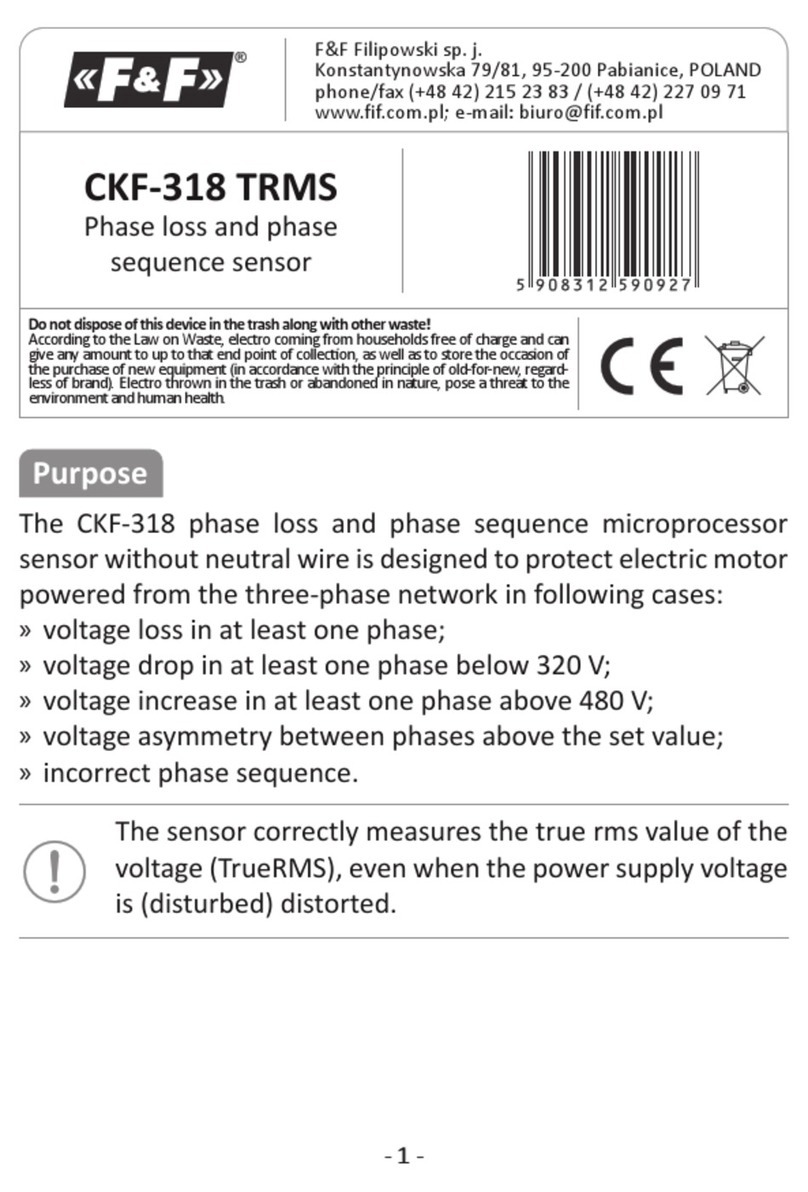
F&F
F&F CKF-318 TRMS manual
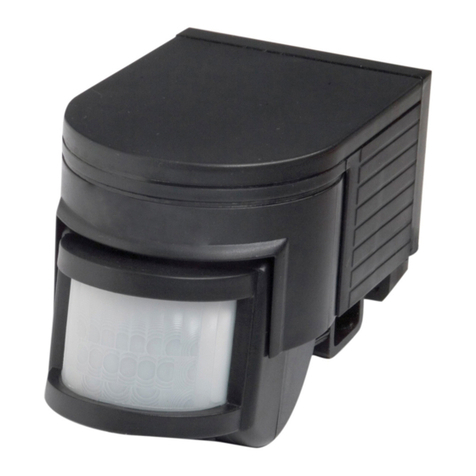
Robus
Robus R180-01 Instruction leaflet
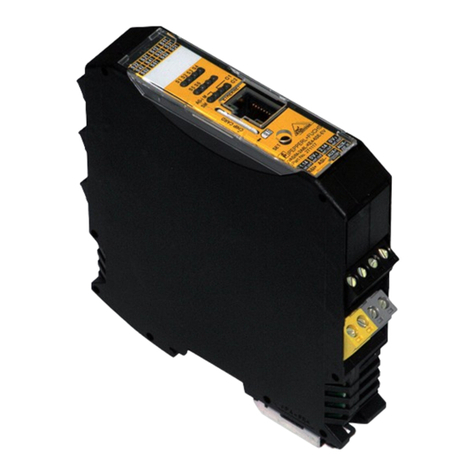
Pepperl+Fuchs
Pepperl+Fuchs VAS/M-2A8L-KE4-6SE-EV operating instructions
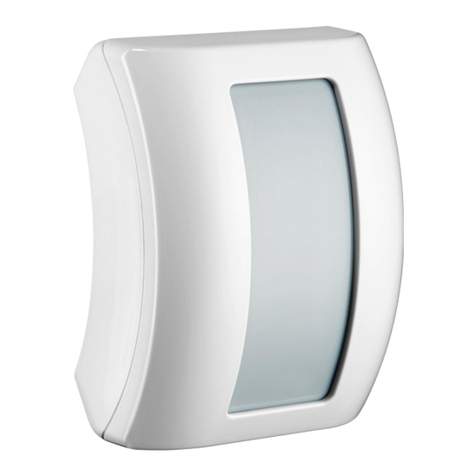
Elkron
Elkron IRT600 Installation, programming and functions manual
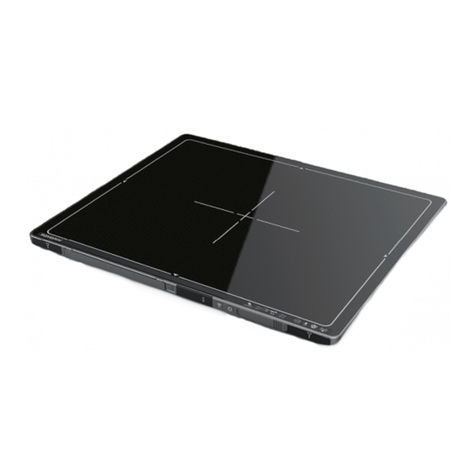
rayence
rayence 1417WGC User & installation manual
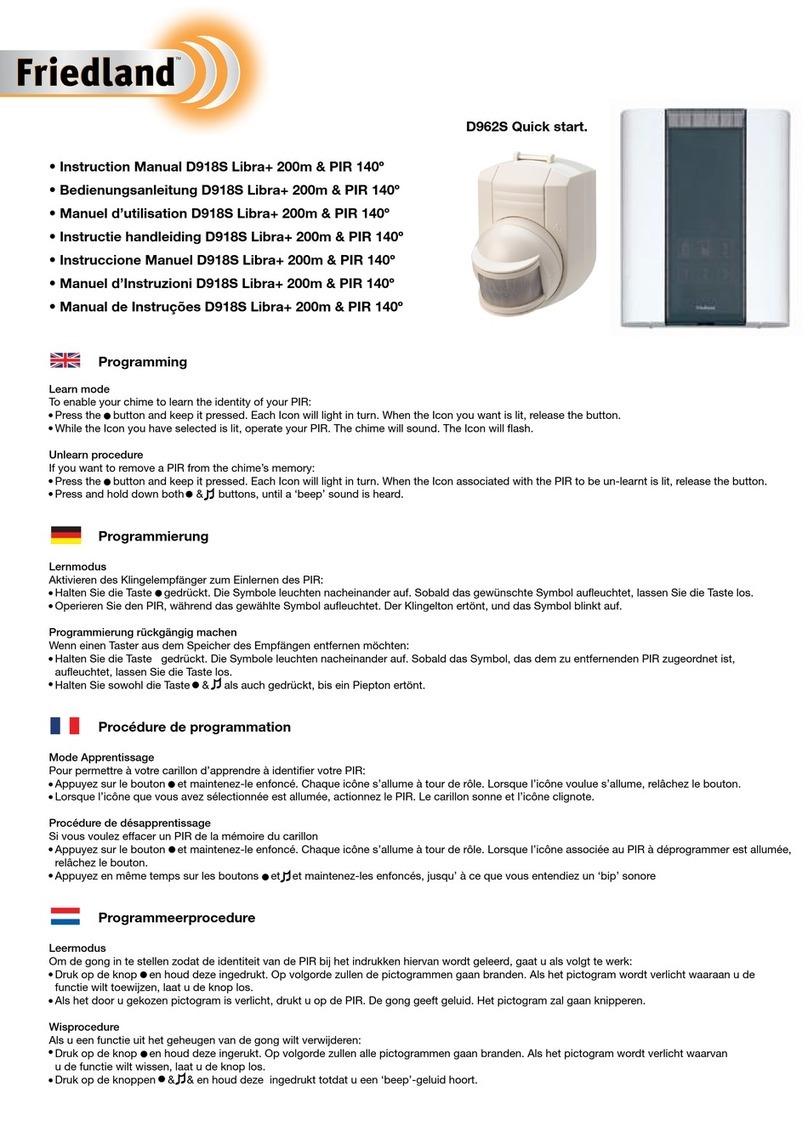
FRIEDLAND
FRIEDLAND D918S Libra+ instruction manual
